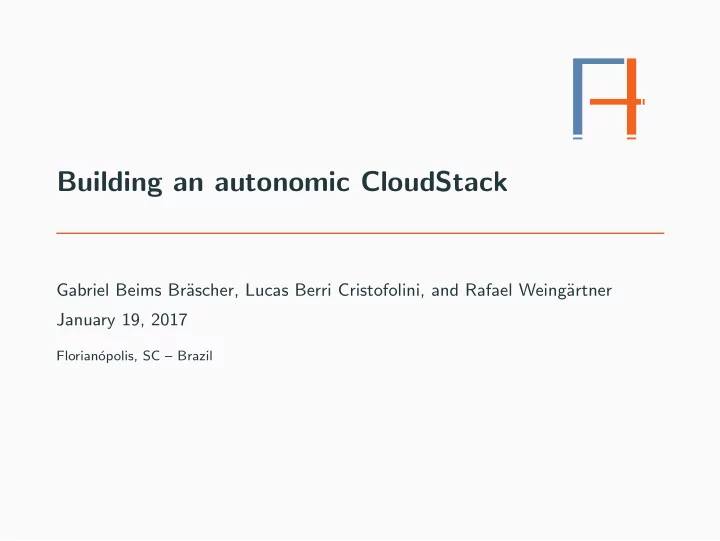

Building an autonomic CloudStack Gabriel Beims Br¨ ascher, Lucas Berri Cristofolini, and Rafael Weing¨ artner January 19, 2017 Florian´ opolis, SC – Brazil
Agenda Current cloud environments The cloud we want How far are we from software like that? Preliminary experiments 2 / 27
Current cloud environments
Poor management of computing resources 4 / 27
The cloud we want
How a cloud managed by software agents looks like 6 / 27
A bit of literature (Automatic Vs Autonomic) Automatic • Programmatic behavior • Meant to be used in well known and closed environments • It takes the form of a well defined script Autonomic • Can do everything that automatic systems do • Has the ability to analyze a set of monitored data • Can trace actions to be executed in order to fulfill goals • An autonomic system is not tied to an implementation per se; it can adapt itself to the environment 7 / 27
Autonomous agents to manage and optimize the cloud 8 / 27
How far are we from software like that?
How far are we from software like that? We are already there! The source code is available at: https://github.com/Autonomiccs/ autonomiccs-platform 10 / 27
Agents basic execution flow diagram 11 / 27
Agents ability I (cloud consolidation) 12 / 27
Agents ability II (cloud balance) 13 / 27
Preliminary experiments
The experiment conducted Description • The proposal was added to Apache CloudStack • used a consolidation heuristic • adopted a host scoring approach based on more than one resource type • the score is used during allocation and consolidation process 15 / 27
The cloud environment used 16 / 27
The heuristic scoring approach Mean of a cluster VMs resource allocation � v i =1 ( memoryVM i ) (1) µ M ← v � v i =1 ( cpuFrequencyVM i ) µ CpuFreq ← (2) v � v i =1 ( cpuCoresVM i ) µ cpuCores ← (3) v Ranking of hosts for allocation and consolidation Hscore = ( Hm µ M ) ∗ ( HcpuFreq µ CpuFreq ) ∗ ( HcpuCores µ cpuCores ) (4) 17 / 27
The cloud environment using Autonomiccs 18 / 27
The deployment test Deployed VMs • 10 small virtual machines • 5 large virtual machines Table 1: Test VMs’ configuration. VM type Amount CPU RAM S 10 1.0 Ghz 256 MB L 5 1.8 Ghz 2.0 GB 19 / 27
The cloud environment after the deployment of test VMs 20 / 27
Deployment time without Autonomiccs Figure 1: Deployment of VMs in our cloud environment without Autonomiccs framework (using logarithmic scale). 21 / 27
Deployment time using Autonomiccs Figure 2: Deployment of VMs in our cloud environment with Autonomiccs (using logarithmic scale). 22 / 27
The results Table 2: Average time to deploy VMs CS + Difference CloudStack Autonomiccs in % Total time to 32 seconds 558 seconds 1,643.75 % deploy 15 VMs Total time 32 seconds 186 seconds 481.25 % excluding S5 VM 23 / 27
The results Benefits perceived • The agent identified hosts 2, 4, 5, 6 and 7 as available to power off • it reduced the number of running servers in 62.5% • no need to rely on system administrators Problems found • The delay on servers activation if needed • unexpected behavior found on Apache CloudStack monitoring module when it is used in cluster 24 / 27
Conclusion In summary • Autonomiccs framework enables the autonomic management of Apache CloudStack • as shown before, despite some hiccups, Autonomiccs framework has potential • the source code is open and available at: https://github.com/Autonomiccs/autonomiccs-platform 25 / 27
Let’s start a partnership? We need help to push our startup further. Let’s be partners! 26 / 27
The end Thank you all! Any questions? for further inquiries: rafael@apache.org 27 / 27
Recommend
More recommend